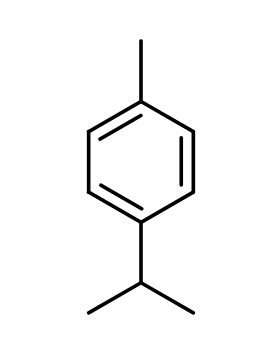
Photo credits: ScenTree SAS
Do you sell any of the raw materials? Would you like to let our users know?
Send an email to fournisseurs@scentree.coto learn about our advertising opportunities.
Do you sell any of the raw materials? Would you like to let our users know?
Send an email to fournisseurs@scentree.coto learn about our advertising opportunities.
General Presentation
-
CAS N° : 99-87-6
-
EINECS number : 202-796-7
-
FEMA number : 2356
-
Density : 0,855 - 0,860 @20°C 0,852 - 0,857 @25°C
-
Optical rotation : Donnée indisponible
-
Allergens : This ingredient does not contain any allergen.
-
Refractive Index @20°C : Donnée indisponible
-
Volatility : Head
-
Price Range : €
-
Appearance : Colorless liquid
-
FLAVIS number : 01.002
-
JECFA number : 1325
Information on synthetic ingredients
-
Acid Value : Donnée indisponible
-
Boiling Point : 176 - 177°C
-
Detection Threshold : Donnée indisponible.
-
Molecular formula : C10H14
-
Log P : 4,7
-
Molecular Weight : 134,22 g/mol
-
Fusion Point : Donnée indisponible.
-
Flash Point : 44°C (111°F)
-
Vapor pressure : Donnée indisponible
Uses
Other comments :
The quality featured here is a quality containing 100% renewable carbon.
Stability :
Data not available.
Uses in perfumery :
Year of discovery :
Data not available.
Isomerism :
Paracymene is the most common isomer, however, orthocymene and metacymene also exist in smaller amounts. They are not widely used in perfumery.
Synthesis precursor :
p-cymene is as a starting material for p-cresol production via the Hock-Lange synthesis pathway La tonalide® aussi first cyclialkylated with neohexene followed by acetylation of the resulting tetralin Acetophenone - Par condensing cymene with acetyl chloride in the presence of AlCl3 Gamma-terpinene - from p-cymene by the action of sodium and alcohol in liquid ammonia. Moskene resulted from condensing p-cymene with i-butyl alcohol in the presence of sulfuric acid and nitrating the resulting product (Barbier, 1932) The first reported ''the active odor principle '' of Phantolid was outlined for the reaction of ί-amyl alcohol and cymene in the presence of sulfuric acid (Weber et al, 1955) - Process remplacé par un autre + optimisé
Natural availability :
Paracymene is found in a very large number of oils. It is one of the most important terpenes in perfumery. It is therefore possible to find this ingredient in its natural state as well as in the overwhelming majority of current chromatography.
Synthesis route :
It has been described that cymene can be produced by alkylation of toluene with either propylene or isopropyl alcohol. Methods for direct conversion of terpenes into cymene have also been described. These methods include for example conversion by acidic clays, oxidation with Cr(VI) compounds and transition metal based reactions. Vapour reactions using pure terpenes and Pd catalysts or Zn/Cr catalysts have been reported.
Regulations & IFRA
This ingredient is not restricted

